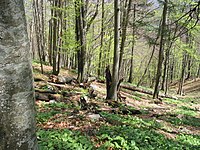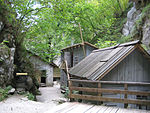World Heritage in Slovenia
World Heritage Sites in Slovenia yellow = world cultural heritage, green = world natural heritage |
The world heritage in Slovenia (as of 2017) includes four UNESCO world heritage sites , including two world cultural heritage sites and two world natural heritage sites. The first World Heritage Site was added to the World Heritage List in 1986 when Slovenia was still one of the six republics of Yugoslavia . After gaining independence in 1991, Slovenia acceded to the World Heritage Convention in 1992, and its first World Heritage site followed in 2011. The last World Heritage site to date was registered in 2017.
The World Heritage Sites in Slovenia include the Historic Sites of Mercury Extraction , the Prehistoric Stilt Houses around the Alps and the Ancient Beech Forests and Primeval Beech Forests of the Carpathian Mountains and other regions of Europe, as well as three transnational World Heritage Sites.
World heritage sites
The following table lists the UNESCO World Heritage Sites in Slovenia in chronological order according to the year of their inclusion in the World Heritage List (K - cultural heritage, N - natural heritage, K / N - mixed, (R) - on the Red List of World Heritage in Danger ).
![]() Map with all coordinates of the World Heritage Sites: OSM
Map with all coordinates of the World Heritage Sites: OSM
| image | designation | year | Type | Ref. | description |
|---|---|---|---|---|---|
|
Škocjan Caves ( location ) |
1986 | N | 390 | The cave system and its surroundings, with some of the most important topographical karst phenomena, including one of the world's largest underground canyons. The Karst region is of particular importance for the history of geosciences. | |
|
Prehistoric pile dwellings around the Alps ( location ) |
2011 | K | 1363 | Cross-border with Germany, France, Austria, Italy and Switzerland. Prehistoric pile dwellings , discovered and uncovered here, date from the Neolithic and the Bronze Age and allow insights into life in prehistoric times. Two locations are in Slovenia, the pile dwellings in Ig, the north group ( kolišča na Igu , severna skupina ), and the pile dwellings in Ig, south group ( kolišča na Igu, Južna skupina ). | |
|
Historic sites of mercury mining: Almadén and Idrija ( location ) |
2012 | K | 1313 | Idrija is one of the two largest mercury mines in the world; Mercury was discovered as early as 1490, the site provides the infrastructure and technology for mercury mining and extraction and is evidence of the intercontinental trade in mercury, which for centuries played an important role in the exchange between Europe and America. Cross-border world heritage with Spain ( Almadén mine ). | |
| Old beech forests and primeval beech forests of the Carpathian Mountains and other regions of Europe | 2017 | N | 1133 | Transnational World Heritage with Albania, Belgium, Bulgaria, Germany, Italy, Croatia, Austria, Romania, Slovakia, Spain and Ukraine. The Krokar Primeval Forest ( Lage ) and the Snežnik - Ždrocle ( Lage ) forest reserve in Slovenia are outstanding examples of undisturbed, complex forests in a temperate climate, and for their postglacial expansion; Their complete and comprehensive ecological composition and the development into pure and mixed stands under diverse environmental conditions are striking. |
Tentative list
The sites that are intended for nomination for inclusion in the World Heritage List are entered in the tentative list .
Current World Heritage candidates
As of 2018, five sites are entered in the tentative list of Slovenia, the last entry was made in 2018. The following table lists the sites in chronological order according to the year they were included in the tentative list.
![]() Map with all coordinates of current World Heritage candidates: OSM
Map with all coordinates of current World Heritage candidates: OSM
| image | designation | year | Type | Ref. | description |
|---|---|---|---|---|---|
| Fužina hill in Bohinj | 1994 | K | 592 | Hilly landscape in Bohinj , which has adapted to the special needs of alpine cattle breeding, with gradual relocation to higher and higher pastures in the summer months. Mountain settlements have developed specific operating structures, for example hayracks . | |
|
Franja partisan hospital ( location ) |
2000 | K | 1433 | The Franja Partisan Hospital was a secret hospital for partisans during the Second World War near the hamlet of Dolenji Novaki, which is northeast of Cerkno in western Slovenia. From 1944 until the end of the war in 1945, it served to care for wounded Yugoslav partisans . Although the Wehrmacht made several attempts to find the hospital, it was never discovered. | |
| Classic karst | 2015 | N | 6072 | The karst in southern Europe is part of the Dinaric Mountains , where the geological form karst was first scientifically studied and after it was named.
Classical karst had already been put on the tentative list as a cultural landscape in 1994 (Ref. 590 ), and in 2015 a new proposal was made as a natural site. |
|
| The path of peace from the Alps to the Adriatic Sea - legacy of the First World War | 2016 | K | 6077 | Are proposed sites along the Isonzo front : Russian chapel at vršič pass , military cemeteries in Log pod Mangartom , Solkan , Štanjel , Gorjansko and Črniče , ossuaries in Tolmin and Kobarid , Holy Spirit Memorial Church in Javorca, historical areas around Zaprikaj, Mengore and Sabotin , Military band in Ladra and the Bohinj Railway | |
| Timeless humanistic architecture by Jože Plečnik | 2018 | K | 6295 | The original proposal from 2015 (Ref. 5968 ) has been revised. Of the buildings by the architect Jože Plečnik in Ljubljana , candidates are the Church of St. Michael , the promenade along the bank fortification, the bridges of the Ljubljanica , Vegova Street with the Slovenian National and University Library , the Trnovo Bridge , the Roman Wall in Mirje and the All Saints' Garden in the Žale Central Cemetery . |
Former World Heritage candidates
These sites were previously on the tentative list, but were withdrawn or rejected by UNESCO. Sites that are included in other entries on the tentative list or that are part of world heritage sites are not taken into account here.
![]() Map with all coordinates of former World Heritage candidates: OSM
Map with all coordinates of former World Heritage candidates: OSM
| image | designation | year | Type | Ref. | description |
|---|---|---|---|---|---|
| Timeless and humanistic architecture by Jože Plečnik in Ljubljana and Prague | 2015-2018 | K | 5968 | After it became clear that the transnational proposal together with the Czech Republic had little chance of success, Slovenia decided to pursue the application on its own and to revise the selection of the individual items of the proposal (Ref. 6295 ). The St. Francis Church in Ljubljana is no longer part of the revised proposal. |
Web links
- Slovenia on the UNESCO World Heritage Center website.
Individual evidence
- ↑ Slovenia. In: whc.unesco.org. UNESCO World Heritage Center, accessed July 22, 2017 .
- ^ Tentative list of Slovenia. In: whc.unesco.org. UNESCO World Heritage Center, accessed March 18, 2018 .
- ↑ Slovenia to proceed with UNESCO listing of Plečnik's works alone. STA (Slovenska tiskovna agencija, national news agency of Slovenia), December 27, 2017, accessed on March 15, 2018 .









